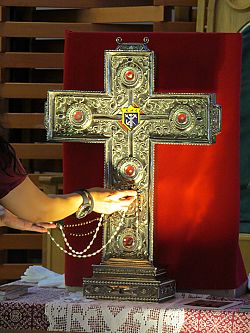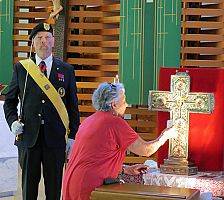Visit of Mexican martyrs’ relics ‘a blessing’
Friday, Oct. 03, 2025

IC photo/Laura Vallejo
Photo 1 of 2
Hundreds of people venerated the relics of the Mexican martyrs St. Luis Batiz Sainz, St. Rodrigo Aguilar Aleman, St. Miguel de la Mora de la Mora, St. Pedro de Jesus Maldonado Lucero, St. Jose Maria Robles Hurtado and St. Mateo Correa Magallanes that were displayed for three days at Saint Joseph the Worker Catholic Parish. Here a person touches the reliquary with a rosary .
WEST JORDAN — For three days the community of the Diocese of Salt Lake City had the opportunity to venerate relics of the Mexican martyrs St. Luis Batiz Sainz, St. Rodrigo Aguilar Aleman, St. Miguel de la Mora de la Mora, St. Pedro de Jesus Maldonado Lucero, St. Jose Maria Robles Hurtado and St. Mateo Correa Magallanes.
All six were priests and members of the Knights of Columbus, the worldwide Catholic fraternal organization. They were martyred in the early 1900s during an anti-Catholic period in Mexico, and were canonized by Pope John Paul II on May 21, 2000.
Having the relics come to Utah was a blessing, said Frank Carmona, Utah Knights of Columbus state deputy.
It took 20 years for the relics to visit Utah, but the wait was worth it, he said. “One of the main focuses of the Knights of Columbus are immigrants. Our organization started with immigrants, and we are all still, so bringing these martyrs to Utah has given us the opportunity to gather all of our immigrant community with no worries, with no violence, without discrimination, with such pure love.”
These martyrs showed “to our Catholic community – and even to non-Catholics that came to visit the relics – that when we gather we can be united,” Carmona continued. “We have been showing love for all without putting any type of tags.”
Bishop Oscar A. Solis, who attended the display of the relics on Sept. 26, thanked those in attendance for “celebrating our faith during this Jubilee Year of Hope as well as our special devotion to the Blessed Sacrament.”
“In the jubilee year … [the late] Pope Francis emphasized the importance of the heroes of our Church, whom we call the saints,” the bishop said. “They are not only a source of inspiration but as well a source of spiritual faith in order to continue our commitment with God and proclaiming the Gospel of Love. … The blood of the martyrs is the seed of our Christian faith.”
As part of the display, on Sept. 27 Jose Labron Sanabria, the Knights State Supreme representative from Florida, presented information about each of the martyrs.
“When these martyrs offered their lives, they did it for their faith but also to transmit a message to the community, a message that faith is and always will be alive,” Labron Sanabria said, adding that he was motivated to make the presentation because many families, “especially the new generations, don’t know about these lives, especially about the martyrdom, the sacrifice, that life of giving from your heart.”
In today’s world people live selfishly, but “these men of God teach us that there is no greater love than giving your life for others,” he said. “To bring this message is also a joy for me; it is a motivation that the new generations can learn that love is more giving than receiving.”
Among those who venerated the relics was Sabrina Jimenez, who was accompanied by her elderly mother. Both women are parishioners of Saint Francis of Assisi in Orem.
“When we heard about this visit I thought, ‘No matter if it rains or shines or whatever the weather is, I’ll be there and bring my mother,’” Jimenez said with tears in her eyes. “We felt so at peace, praying in front of the relics. I cannot describe what I feel now.”
A brief description of each of the martyrs follows.
St. José María Robles Hurtado was a parish priest in Tecolotlán, Jalisco. He was arrested on June 25, 1927 and hanged the next day, blessing his executioners. In its furnishings, the Sanctuary of the Martyrs in Guadalajara uses wood from the tree from which he was hanged.
St. Mateo Correa Magallanes was a priest in Zacatecas. He was arrested while bringing the Eucharist to an invalid. While in jail, he heard the confessions of some of the Cristeros, who were Catholic men fighting against the government’s persecution of the Church. St. Magallanes was ordered by a Mexican general to reveal what the Cristeros had said, but he refused to break the Seal of Confession. He was shot on Feb. 6, 1927.
St. Luis Batiz Sainz also was a priest in Zacatecas. In 1926, before the government closed the church, he was accused of refusing to follow the anti-religious laws. He was captured and shot on Aug. 15 alongside layman Manuel Morales, despite pleading for Morales’ life.
St. Rodrigo Aguilar Aleman was a priest in Unión de Tula, Jalisco. He was hanged in 1927 after being captured when 600 soldiers surrounded his town. He died proclaiming his faith in Christ and Our Lady of Guadalupe.
St. Miguel de la Mora de la Mora, chaplain of Colima Cathedral, continued to celebrate the sacraments even after they were banned by the government. Betrayed and captured along with his brother, St. Miguel was shot while praying the rosary in front of his brother, who was set free.
St. Pedro de Jesús Maldonado Lucero was a priest in Chihuahua. Even after the Cristero War ended in 1929, anti-Catholic sentiment remained. On Ash Wednesday 1937, Fr. Maldonado was beaten by a group of drunken men. He died from a skull fracture. His headstone reads, “You are a priest.”
The stories of these martyrs have been depicted in movies such as the 2012 film “For Greater Glory,” which highlights the Cristero War and the story of 13-year-old José Luis Sánchez, who was a flag bearer for the rebels. He was captured and killed for refusing to renounce his faith.
For questions, comments or to report inaccuracies on the website, please CLICK HERE.
© Copyright 2025 The Diocese of Salt Lake City. All rights reserved.
© Copyright 2025 The Diocese of Salt Lake City. All rights reserved.


Stay Connected With Us